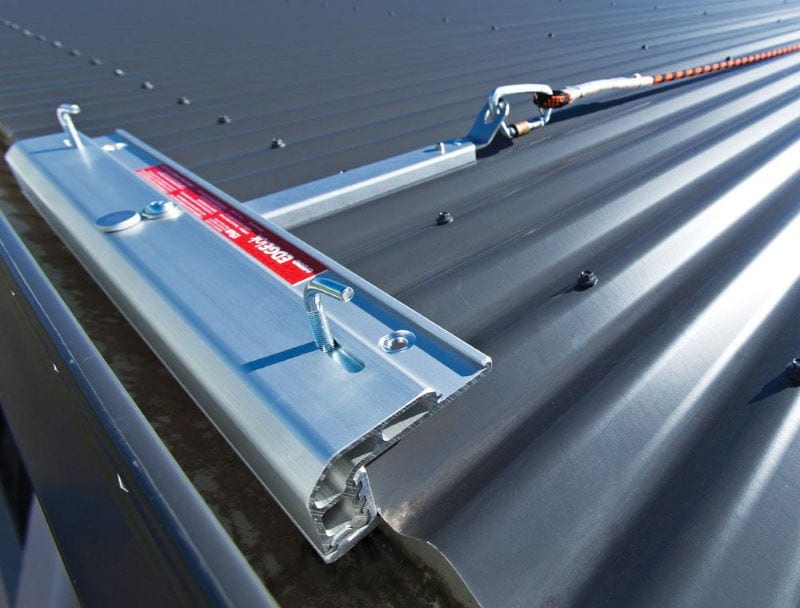Working on the roof is a tough job that includes high risk. The uneven surface, combined with the pitch of the roof, makes it more difficult. Working on these roofs might result in falling, which leads to injury and even death. All workers are entitled to a safe working environment.
The employer must ensure the safety of their employees by using the proper safety measures. They should provide a safe environment for the workers while they are working above certain heights. They are liable under Australian Law in case of non-compliance or violation. Roof anchor points are one of the measures they should take to ensure the safety and security of their employees or any roofers contracted to work on-site.
Selecting a roof anchor is not always easy because of the range of different materials used to construct roofs, like concrete tiles and slate, Terracotta tiles, COLORBOND, and other metal sheets.
What is a roof anchor point?
An Anchor Point is an essential part of the fall protection system, installed on the roof. It connects with height safety personal protection equipment to facilitate safe working at heights. Workers have to attach safety harnesses, ropes, and other safety equipment to be safe.
Roof anchor points may be temporary or permanent, both types are available. It is very important to install roof anchors to ensure the safety of you or your employees in case of any hazards.
Key considerations to select a Roof Anchor point
An important part of installing the roof anchor point is the appropriate placement on the roof. Besides this, consider:
- What type of fall arrest energy-absorbing design?
- What type of forces are required by the anchor point to withstand?
- Type of anchor compatible with the lanyard you are using.
- What type of duties will you perform using the anchor point?
What is the difference between fall arrest and rope access anchors?
There are a couple of over systems that can also be used to prevent falls:
- A fall arrest system: A fall arrest system arrests the worker in mid-air once the fall has occurred and prevents them from falling down to a lower level.
- A rope access system is a method of enabling work to be carried out on atriums, facades, or exterior areas at height using a rope abseil system.
Learn about the differences between fall arrest & rope access anchors.
Roof anchor points for different Roofs
- Metal Roof Anchor Point: Designed for steel roofs. Generally made of stainless steel and is easy to install. It is useful for the steel roof with steel purlins. The installation of this anchor point is simple by pre-drilling holes in-line. The spacing should be with industrial rivets.
- Tiled Roofs- Anchor Point: A design for a tiled roof that fits between the two tiles. Remove a tile that sits over a rafter screw and place the anchor point into the rafter at the correct height. It allows the attachment point to protrude below the tile. Then the tile was placed back in its original position.
How to choose the right roof anchor point
Some Guidelines to remember when choosing a roof anchor point:
- Prefer a steel roof anchor point.
- A professional inspection of anchor bolts, through-bolts, and plate washers
- Anchor points with conjunction should use the equipment. It includes eye bolts, turnbuckles, concrete embeds, and beam clamps.
- Inspect and test the load-bearing capacity of the roof anchor point.
- You should check the energy-absorbing properties of the roof anchor.
Australian Standards for Roof Anchor Point
Australia has certain standards related to roof anchor points. These include:
AS/NZ 1891- Industrial fall arrest system and devices
This standard is the common effort of the Australian/New Zealand committee. The standard includes the specification of material for manufacturing, design, and testing. The various types of equipment include harnesses, lanyards, and pole yards. It also includes connecting devices and personal energy absorbers.
AS/NZ 4488 – Industrial rope access systems
This standard includes various factors to consider specification, use, and maintenance. The pieces of equipment include the harness and industrial safety belts.
AS/NZS 5532
This standard includes the manufacturing rule for single-point anchor devices. These devices include harness-based work at height. Every single-point anchor must pass the below four tests with both the anchor and the structure:
1. Dynamic load in line with the roof sheet- 15 kN
To perform this test, they need a 100 kg mass drop from a height of 2 meters off the anchor while installing on the roof.
2. Static load in line with the roof sheet- 15 kN
The anchor was installed onto the roof deck, and a load of 1530 kg (15 kN) was held on the anchor for three minutes.
3. Dynamic load across the roof sheet- 15 kN
The third test is the same as test 1. Yet, rather than loading the anchor with the roof deck and turning it 90 degrees loaded across.
4. Static load across the roof sheet- 15 kN
The fourth test is the same as test 2. But this test is performed by loading the anchor across the roof deck.
Other Key Points to Consider
There are certain points to consider when installing roof anchor points:
- Make sure the companies offering the service follow the safety standards. In case the company quotes a cheaper price and promises turn-around time. It might result in dangerous circumstances.
- Make sure companies you are hiring use anchor points manufactured to Australian standards.
You are responsible for choosing the right roof anchor point for safety reasons. Make sure all standards are met.







